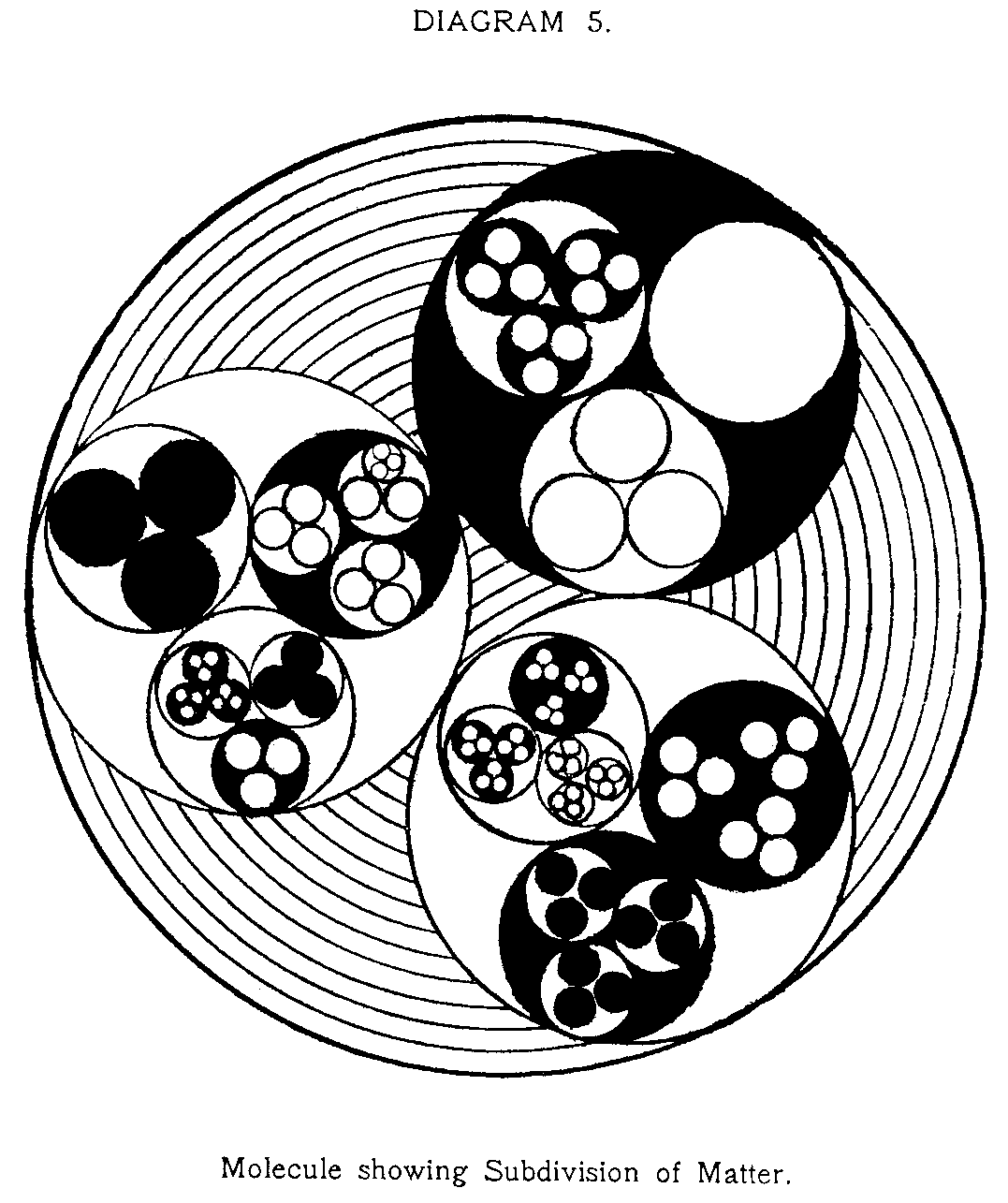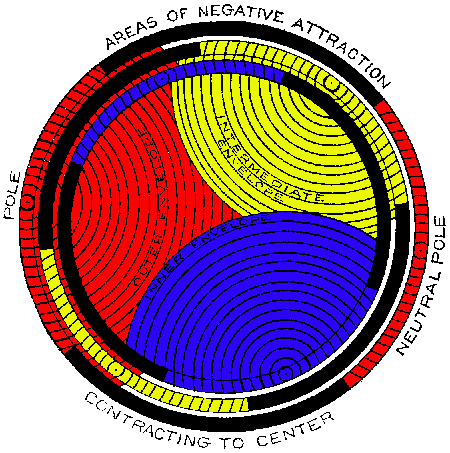Also called "rotating etheric envelope", "etheric capsule", "envelope", "shell", etc.
Keely
"Each disc of the polar and depolar groupings in the propeller of the air-ship contains seven pints of hydrogen. In preparing these discs, the hydrogen is submitted to a triple order of vibration. The corpuscular envelopes of the molecules are not enlarged in volume, under their receptive condition, but their velocity of rotation is increased. While under the operation of this transmittive vibration their vortex action is made visible." [Newton of the Mind]
"All moving bodies of visible matter produce heat as according to their velocity. The flow of gases only induces thermal reduction from molecular friction. By this term it must not be understood that the molecules actually come in contact, and rub against each other. There is no pressure, however great, that can cause molecular contact. The area of the volume of the molecule can be reduced by enormous pressure, and the tension thus brought to bear on their rotating envelopes induces heat. The heat thus induced is a positive proof of the wonderful velocity of the etheric envelope. If the molecules were dead - which is an infinite impossibility - to sympathetic vibration, and without a rotatory envelope if all the pressure possible to conceive were brought to bear upon them, it would not induce the slightest thermal change." [Vibratory Physics - The Connecting Link between Mind and Matter]
See Ultimate Constitution of Matter and Action of Force Regulating its Phenomena wherein these envelopes are described by Keely. Sections eight through twelve are presented here. [See Angular Momentum coupling for modern terminology.]


Eight: These molecules have an envelope, rotating with inconceivable rapidity, formed of a high tenuous ether, whose place in the order of subdivision ranks third, the three divisions being, - first, molecular; second, atomic; third, atomolic. (Atomolic is the same as Etheric)

Ninth: This atomolic substance has a density approximately 986,000 times that of steel, enabling it to permeate steel as light penetrates glass; this rotating envelope of atomolic substance is in a liquid condition. There are four conditions of matter; viz. solid, liquid, gaseous, and ultra-gaseous. These conditions result from greater or lesser range of oscillation of the composing units individually; this is equally true, whether the units are molecules, atoms, atomoles, planets, or suns. But one LAW governs all matter. [See Subdivision]

Tenth: This molecular envelope, rotating with such great velocity, holds in its embrace the next subdivision of matter, the atomic. There cannot ever be more or less than three atoms in any molecule. These are placed so as to form a triangle in the interior; they rest in a condition of substance, or matter, we will term intermolecular. In this intermolecular substance we find an enormous energy or force in bondage, held thus by the rotating envelope enclosing it. Were we to rotate a spun brass shell, say nine inches in diameter, at a very much less rate of speed than that at which the molecular envelope rotates, - say nine hundred revolutions per second, - its equator would first bulge out, then form into an oval disk. A solid block of wood subject to such revolution would swiftly fly to pieces. The rotating envelope of a molecule, unlike these, the greater the velocity of rotation, the greater is its compression toward the center of the molecule. The rotation of this envelope is of such a nature as to produce an internal pressure upon every portion from every point of the molecule as a sphere. Were we to consider a rotating envelope as ordinarily understood, it would be one in which the envelope rotated around an equator having poles of no rotation; i.e., the poles would not possess the compressing force of the equator; the result would therefore be a compressed equator, and the intermolecular substance would pass out without resistance at the poles.
Eleventh: If it be possible let us conceive of an envelope with an equator, but destitute of poles, a number of these rotating over the sphere, this atomolic envelope possessing an almost infinite attractive force toward the center of the molecule, pressing in the intermolecular substance, where it is held until this revolving envelope becomes negatized by a certain order of vibration, when the enclosing matter rushes out to its natural condition of concordant tenuity, as in the case of gunpowder, dynamite, and nitroglycerine. This force, we must see, has been held in the embrace of the rotating envelopes of the unit structures, or where does it come from? This force at the time of an explosion was liberated by shock or fire, both being orders of imparted motion or vibration. How much greater the result would be were we to associate a scientific instrument now completed, and shortly to be given to the world, with such an agent as nitroglycerine; one pound of nitroglycerine would have its destructive force augmented beyond all possible control. These instruments are carefully concealed by wise masters from all persons save the few who are already prepared to study their potency with the exclusive end in view of aiding the real scientific progress of humanity; and, furthermore, it may be truly stated that a ferocious sensualist, however powerful his intellect, would be utterly unable to either comprehend or operate one of these marvelous constructions.


Twelfth: Next in order of consideration is the second subdivision of matter - the atomic. The atom has the same rotating envelope as the molecule, governed by the same laws of rotation and compression. The rotating envelope holds in its embrace the interatomic substance and three atomoles resting in it, the atomoles within the atom being constructed after the same pattern as the atom and the molecule, obedient to the same laws; the atomolic being simply the third subdivision of matter. The threefold order is absolutely universal.

See Also
1.5 - Fractal Structure of Matter
1.6 - Structure of Matter
13.01 - Math Structure a Place to Start
13.08 - Atlins Neutral Center Structure and Dynamics
7.17 - Eighth
7B.03 - Dynaspheric Shells
AFFINITY OF ETHERIC CAPSULES
atmospheric envelope
ATOMIC STRUCTURE
atomolic envelope
7B.03 - Dynaspheric Shells
capsule
COMPLEX STRUCTURE
crystalline structure
DISINTEGRATION OF ETHERIC CAPSULE
Dynasphere
Dynaspheric Force
electron shells
encasement
energetic structure
Envelope
Etheric Capsule
Etheric Elements
etheric envelope
etheric structure
Figure 3.3 - Orthogonal Structure and Dynamics
Figure 4.12 - Keelys Formative Structural Dynamic Morphology
Figure 4.14 - Feynmans Triplet Structures of the Proton and Neutron
Figure 6.0.5 - Cube with Vortices showing Structural Relations
Figure 6.1 - Orthogonal Vortex Motion as Structural base of Cubes
Figure 6.13 - An Introductory Matrix Structure
Figure 7B.03 - Dynaspheric Shells and Attractive Compressing Equators
Figure 7B.09 - Feynmans Triplet Structure of Photon
Figures 3.31 - Vortex Orthogonal and self-contained Motions - Structure
fine structure constant
Fine Structure
fine-structured opposites
floral envelope
homogenously structured
Hyperfine Structure
Lewis structure
mathematical origin and structure
Matter
MEASURING THE VELOCITY OF THE ETHERIC CAPSULE
molecular envelope
molecular structure
molecule
morphous structure
New Concept - XXVIII - Vibrating Matter - The Root Principle of Atomic Structure
organic structure
polar envelope
restructure
rotating envelope
ROTATION OF THE ETHERIC CAPSULE
rotatory envelope
snail shell resonator
Structure
structure-loosening
structure-reducing
structuring
superstructure
Table 11.01 - Scale of Infinite Ninths its Structure and Base
Table 11.05 - Comparison of Scale Structural Components and Relations
Table 13.01 - Suppositional Math and Symbolic Structure
terrestrial envelope
terrestrial magnetic envelope
tissue-structure
triple combination of the magnetic terrestrial envelope
unity of structure
